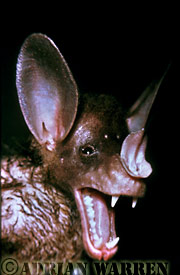The West Indian legends, in Trinidad at least, must occasionally be reinforced by the odd person who gets bitten by a true vampire, a small brown bat about 100 mm (4 in) long that feeds exclusively on blood, usually of animals rather than that of people. These little bats were not, as is popularly supposed, the model for Dracula: it was the other way round.
When European explorers first arrived in South America, they were fascinated by the blood-feeding habits of these bats and christened them 'vampires' after those restless souls from Transylvania who rose from their graves on dark nights.
There are three different kinds of true vampire bats: by far the most common is Desmodus which feeds mainly on the blood of mammals; Diaemus, somewhat rarer and preferring birds as prey; and finally Diphylla, a rare bat about which hardly anything is known and which differs little from its cousins except that it has very hairy thighs. One thing they have in common with each other is that they are just as at home on the ground as in the air; most bats, if put on the ground, flop around awkwardly with their wings half spread and have difficulty in taking off. Vampires, however, have elongated forearms and are extremely muscular; with wings neatly tucked in, they can run on the ground with ease and at great speed. When taking off they spring high into the air before spreading their wings for flight. The ability to run on the ground is of great value to vampires, allowing them to locate their prey on the wing then land at a safe distance, finally approaching from the ground. It also enables the bat to escape effectively after feeding when it may be too heavy with blood to fly.
Given that these bats only operate on the darkest nights, live in dark caves and carry potentially dangerous diseases like rabies, a 'private life study' of the vampire was a somewhat difficult assignment for a film. Understandably, when the idea was put forward it was met with scepticism and uncertainty, although with sufficient enthusiasm to approve an experimental filming trip to try to obtain a sequence of vampires feeding. No consideration at that stage was given to the problem of showing such a grisly spectacle on television; we did not even know if we would be able to film anything at all. Choice of location was important; if we chose the wrong one we might sit for ten days and not see a single bat. Trinidad seemed to offer the best opportunities, not because there are necessarily more vampires there than anywhere else but following serious outbreaks of rabies there in the 1950s and '60s, a bat control group had been formed to monitor vampire populations and attacks on domestic stock. Consequently all the major vampire roost were well known.

